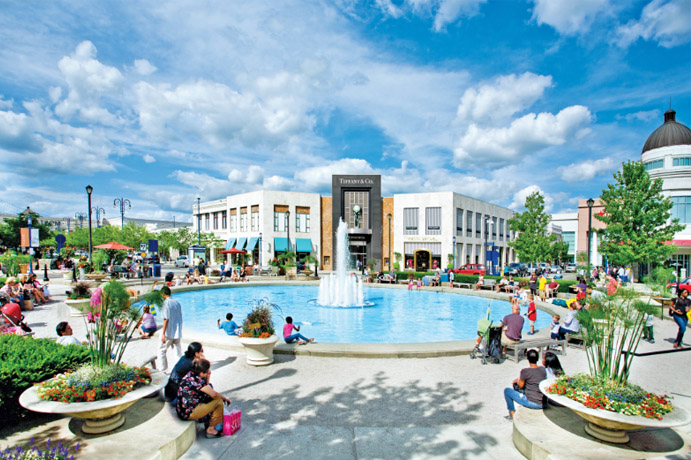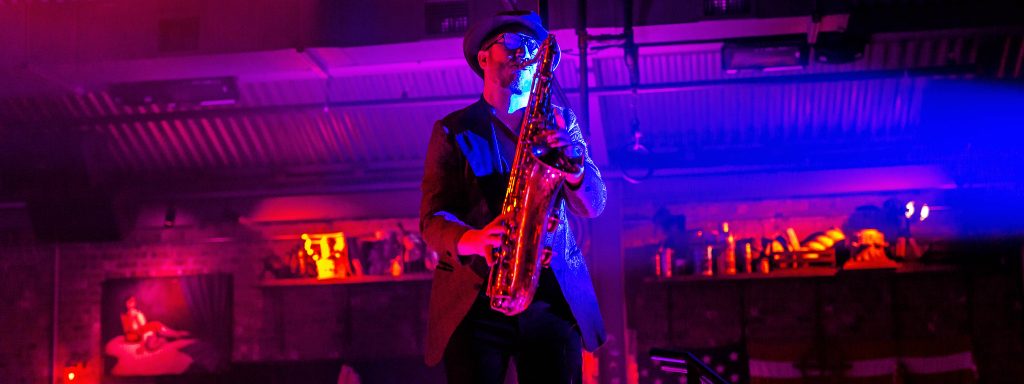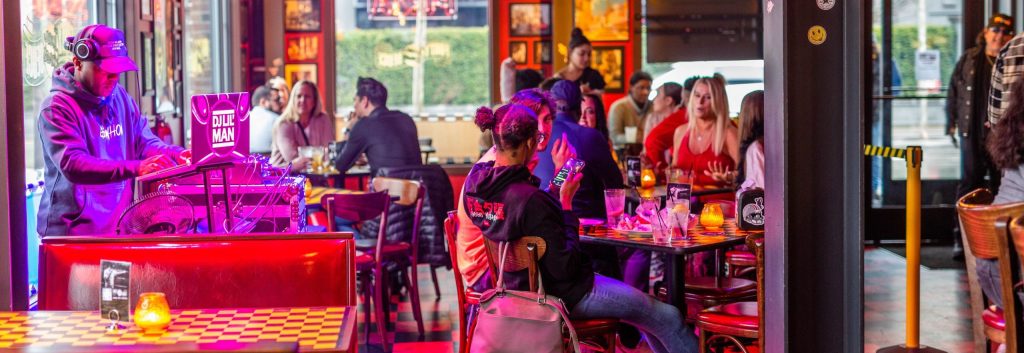By David Gelles, New York Times
COLUMBUS, Ohio — It was a scorching day outside, hot even for late summer in Ohio, and yet I was freezing. I had stepped inside the EB Ice Box, a meat-locker-like display at the Eddie Bauer store here that was cooled to 13 degrees Fahrenheit. The metal-sheathed room looked out onto the promenade of an upscale shopping mall, and featured a large block of ice for a bench. Even though I was wearing a down jacket (the room is meant to be a place where customers can test Eddie Bauer wear), the frigid air had gotten under my skin.
The ice box was a gambit designed to attract the one thing so many stores like Eddie Bauer seem to be missing these days — customers.
For shoppers, this city of 860,000 smack in the middle of a swing state, can feel like an alternate reality, a place where up is down and down is up. Frumpy department stores feature personal shopping services and boutique wellness amenities. Workaday grocery stores like Kroger offer exotic fruits and freshly baked artisan breads.
Even the fast-food business is living in the future. McDonald’s is offering table service from friendly waiters. Robots are taking orders at Wendy’s. Chipotle started a chain that serves hamburgers.
That kind of experimentation has long been a feature of the Columbus shopping scene, but these days it stems as much from desperation as from innovation. The physical retail market, crumbling in the face of competition from e-commerce sites, is in the midst of a transformation as fundamental as the one that shifted consumers to suburban shopping malls — and away from Main Street — half a century ago.
Upstart brands powered by social media are stealing customers from established companies, and the carnage is widespread. More than a dozen major retailers, from Toys “R” Us to Payless ShoeSource, have sought bankruptcy protection this year. Thousands of stores have closed.
Now, as brick-and-mortar retailers around the country stumble, the experimentation has taken on new urgency. Stores are trying out all manner of gimmickry — anything, really — to win back shoppers. And when brands want to try out new concepts, they often come to Columbus.
“We are Test Market, U.S.A.,” said Irene Alvarez, director of marketing and communications for Columbus 2020, a trade group that promotes the region. “We decide the fate of cheeseburgers and presidents here in Columbus.”
A combination of demographics, geography and luck turned Columbus into the nation’s consumer laboratory. This Rust Belt city has historically been a microcosm of the national population’s age and ethnicity, ranking fourth among metropolitan areas in its resemblance to the United States over all, according to data compiled by WalletHub.
“It’s a perfect melting pot for folks like us to test new concepts,” said Roger Rawlins, chief executive of DSW, the shoe retailer, which is based in Columbus.
Ohio State University’s 65,000 students mean young shoppers are always on hand. Columbus is within a day’s drive of nearly half of the United States population, making it a convenient hub for distribution. The city’s relatively small size and contained media market make it affordable for companies to run advertising campaigns and measure their effectiveness. And its relatively low profile allows brands to try something and fail — without the scrutiny they would draw in New York or Los Angeles.
Perhaps most important, a robust network of retailers and service providers — from big brands like Abercrombie & Fitch to small design firms that focus on store layouts — has taken root in Columbus. Today there are more fashion designers in Columbus than in any other American city besides New York and Los Angeles.
But despite the central role that Columbus plays in the retail industry, there are no clear signs that all this experimentation will be able to save the hometown brands. Half a dozen major retailers — from Abercrombie & Fitch to the parent company of Victoria’s Secret — have their headquarters in Columbus. Just about all of them have suffered significant declines in their market value over the past year. Retail employment is falling.
Local boosters put an optimistic Midwestern spin on the situation. “A lot of the challenges that retailers are grappling with, there’s a whole ecosystem of companies here who are working on fixing that,” Ms. Alvarez said. And in Columbus and beyond, there is much about the retail business that needs fixing.
‘America Overbuilt’
Shoppers in Columbus once flocked to two malls, Eastland and Westland. Two decades ago, both were thriving retail temples, anchored by department stores, stuffed with windowless shops and served by mediocre food courts.
Today Westland is a “zombie mall,” abandoned by companies and consumers alike. Its final tenant, Sears, moved out this year, part of the iconic American retailer’s long, painful demise. That left the complex vacant, little more than a subject for photographers who find apocalyptic beauty in the desolation.
On the other side of town, Eastland is not faring much better. Most of the big brands have moved out, leaving just a collection of eyebrow salons, discount retailers and off-brand fast-food providers.
The demise of Eastland and Westland is part of a broader story of American retail in decline. In Columbus, retail vacancy rates are on the rise, up to 6.7 percent in the first quarter of this year, according to the Columbus Chamber of Commerce. Rents are soft, too, down to their lowest levels since 2012. And the same story is playing out across the country, as the malls that defined how Americans shopped for much of the last 50 years shut down.
“There are a lot of zombie malls out there,” said Steve Morris, a co-founder of the Asset Strategies Group, a Columbus firms that helps companies manage their real estate holdings. “We’re just over-retailed in the U.S.”
Yaromir Steiner, a real estate developer, concurred “We’ve been building malls like there’s no tomorrow,” said Mr. Steiner, chief executive of Steiner & Associates. “America overbuilt.”
Yet Mr. Steiner, it could be argued, is partly responsible for the slow demise of centers like Eastland and Westland. He is a disrupter in the mall industry, and his most successful development, Easton Town Center, on the northeast edge of the city, serves a vital role in the test market ecosystem.
In the early 1990s, Mr. Steiner, a Turkish immigrant, was an aspiring developer in Miami. Asked to help develop a shopping center in the upscale Coconut Grove neighborhood, he took a cue from the bustling open-air commercial districts of Istanbul. Instead of building a big box and stuffing stores inside, he proposed turning the mall inside out, placing shops along tree-lined pathways and bringing in upscale restaurants with outdoor seating.
The result was CocoWalk, a shopping center that, improbably, was a pleasant place to spend time. Industry insiders took note, and before long Mr. Steiner was approached to develop a larger project in Columbus.
Working with some of the most influential retail forces in Columbus, Mr. Steiner designed and now manages Easton Town Center, a development that is less a mall than a small city. In addition to hundreds of stores, there are millions of square feet of office space, restaurants, apartments and hotel rooms.
It was hardly a guaranteed success. “A guy with an accent comes from Miami and says we’ll do an open-air project in a place that gets 40 inches of snow?” Mr. Steiner said. “I didn’t stand the chance of a snowball in hell.”
But more than two decades after it opened, Easton Town Center has helped create a new template for American shopping. There is a Tesla dealership, an Apple store and dozens of luxury shops, many of them doing brisk business.
Easton Town Center is also where many retailers do their experimenting. The Eddie Bauer store is there. Nearby, an explosion of neon lighting and skimpy lingerie signals the presence of a La Senza store, a Canadian brand that is just being introduced to the United States. And around the corner, Lane Bryant, the plus-size women’s clothing company, has introduced LaneStyle Studio, a personal shopping program that offers customers one-on-one appointments.
The test market activity continues up the road at Polaris Fashion Place, another high-end mall. There, Lane Bryant is replicating its personal shopping experiments, and Abercrombie & Fitch debuted its first new store design in 15 years in February, replacing its traditional shadowy décor with warmer, better-lit displays.
Also at Polaris, Mr. Rawlins, the chief executive of DSW, is tinkering with his own business model. At a location he calls “the lab store,” Mr. Rawlins is testing new offerings including shoe rental, shoe storage and cobbler services, even a nail salon.
“We’re looking for other ways to retain our customers,” he said.
A Retail Silicon Valley
Les Wexner, a Columbus native, remembers that when he attended Ohio State University in the late 1950s, his professors told him an unusual fact: Columbus was a major test market for consumer goods companies. When corporations wanted to see if a new soap or detergent would have broad appeal, they came to Columbus.
A few years later, Mr. Wexner opened his first women’s clothing store in town, calling it The Limited. As the company expanded, he took his education to heart, trying out new styles and store designs in his hometown before rolling them out to new markets.
“Before I even started the business, Columbus was a great test market,” Mr. Wexner said in an interview. “The customers here were average, and the thinking was that things they liked or rejected would be predictive for the rest of the country.”
The strategy worked. The Limited grew into a retail behemoth. Over the years, Mr. Wexner acquired some brands and introduced others, and at one time or another owned Lane Bryant, Abercrombie & Fitch and Express under the umbrella of his company, L Brands. All along the way, he tested new ideas.
“Les was never satisfied,” said Denny Gerdeman, who once designed stores for Mr. Wexner and is now a co-founder of the Columbus design firm Chute Gerdeman. “Every six months we had to redesign the stores.”
Mr. Wexner, the longest-serving chief executive of a major American company and a billionaire many times over, is not particularly modest about his accomplishments.
“Walt Disney invented characters, and I invent businesses,” Mr. Wexner said. “We’re constantly inventing, reinventing and spinning off businesses.”
To be sure, Mr. Wexner made his fortune with a preternatural ability to see retail’s future. He anticipated the rise of casual attire, spotted underappreciated brands and knew when to sell them off before they lost their luster.
Mr. Wexner’s penchant for experimentation extended beyond his stores, too. It was he, along with a developer called the Georgetown Company, who called up Mr. Steiner in Miami and helped develop Easton Town Center.
Over the years, Mr. Wexner spun off most of the brands he had acquired, seeding Columbus with a new crop of independent companies that in turn tossed off their own spinoffs and imitators. And over the years, an industry emerged. In same way that Hewlett-Packard gave birth to Silicon Valley’s technology sector, Mr. Wexner’s relentless deal making has spawned a
network of companies that now shapes people’s tastes from coast to coast.
Today the L Brands headquarters share a campus with Express, which is now a public company of its own. The Abercrombie & Fitch headquarters are a short drive away.
“It all stems from Les Wexner,” said Steve Zawada, chief operating officer at Eloquii, a plus-size women’s clothing company based in Columbus.
But with few exceptions, the industry that Columbus helped create is now under threat. After years of job gains, retail employment in Franklin County, which includes Columbus, has decreased over the last year, according to the Columbus Chamber of Commerce. Today, retailers employ some 68,000 people, down from more than 93,000 in 2001.
Shares of Express are down about 45 percent this year. Ascena, the Columbus company that now owns Lane Bryant, has seen its stock plummet by 69 percent over the same time. And Abercrombie & Fitch and DSW have also fallen over the last full year.
Even Mr. Wexner’s company, after decades of success, appears to be in decline. Shares of L Brands, which today includes Victoria’s Secret, Bath & Body Works, Henri Bendel and La Senza, have fallen by 42 percent over the past year. Sales at Victoria’s Secret were down 12 percent from last year through September, as women buy their lingerie elsewhere.
“I’m perfectly willing to accept that women may never wear bras,” Mr. Wexner said, tossing aside the notion that his products might one day be obsolete. “But probably women will still wear bras. The categories we are in we think have futures.”
Empty Stores
Columbus isn’t the only place where retailers are trying out new concepts, of course. In New York, Saks Fifth Avenue is offering salt room therapies and workouts led by ex-cons. Climbing walls and trampoline parks are filling the spaces once occupied by department stores. And in Columbus, there are some unlikely new success stories.
Brian Kellett and Emily Brown, both recent graduates of the Columbus College of Art and Design, founded Stump, a chain of stores selling houseplants to a mostly millennial clientele. While name-brand clothing stores have a hard time moving merchandise, Stump has no such problems. On a recent Thursday morning, dozens of new plants wrapped in brown butcher paper were being delivered to one of the stores, which was restocking after most of the week’s inventory had sold out.
Older brands can only hope for such happy problems, and instead are left trying to innovate their way back to relevance.
Near Ohio State University, Wendy’s has unveiled a revamped restaurant that features a raft of changes. Designed by Chute Gerdeman, the location features paper menus instead of the traditional menu board. There are digital ordering kiosks, in place of cashiers. Once customers have placed their order, they wait at a table for a server to deliver their meal.
Smaller details are being tinkered with, too. The trays have higher edges to reduce spills. Fries are served in cups instead of sleeves. Through a partnership with the digital music service Pandora, Wendy’s curates the restaurant’s playlist based on what people in a five-mile radius are listening to. There is even counter seating that looks into the Wendy’s kitchen, where line cooks are preparing salads made to order — a first for the chain.
“Customers have a certain idea about what they think fast-food restaurants are,” said Abigail Pringle, chief development officer at Wendy’s, which is based in the Columbus region. “We’re trying to shake that up.”
Then there is the EB Ice Box. Colin Berg, Eddie Bauer’s brand historian, said the idea was actually an old one. In the 1950s, Eddie Bauer himself would instruct employees to spend time in cold storage lockers and make sure the company’s parkas kept them warm.
But the company may have to do more than install a nifty in-store display to ensure a successful future. Mr. Berg said “anecdotal evidence” suggested that the EB Ice Box had been a hit with customers, who enjoy popping in for a blast of arctic air. Yet on a series of recent afternoons, the EB Ice Box, along with the Eddie Bauer store itself, was mostly empty.






